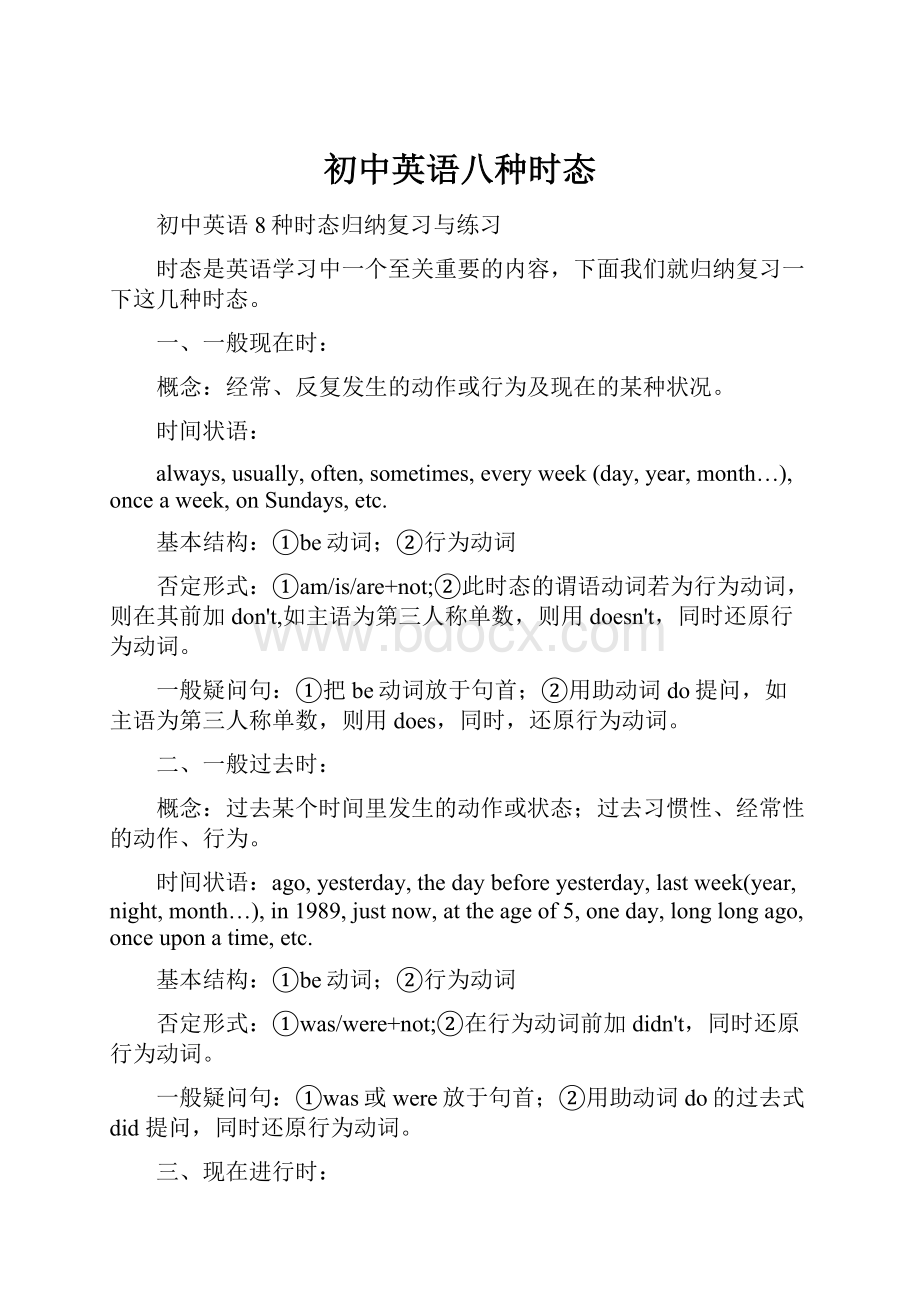初中英语八种时态.docx
《初中英语八种时态.docx》由会员分享,可在线阅读,更多相关《初中英语八种时态.docx(12页珍藏版)》请在冰豆网上搜索。

初中英语八种时态
初中英语8种时态归纳复习与练习
时态是英语学习中一个至关重要的内容,下面我们就归纳复习一下这几种时态。
一、一般现在时:
概念:
经常、反复发生的动作或行为及现在的某种状况。
时间状语:
always,usually,often,sometimes,everyweek(day,year,month…),onceaweek,onSundays,etc.
基本结构:
①be动词;②行为动词
否定形式:
①am/is/are+not;②此时态的谓语动词若为行为动词,则在其前加don't,如主语为第三人称单数,则用doesn't,同时还原行为动词。
一般疑问句:
①把be动词放于句首;②用助动词do提问,如主语为第三人称单数,则用does,同时,还原行为动词。
二、一般过去时:
概念:
过去某个时间里发生的动作或状态;过去习惯性、经常性的动作、行为。
时间状语:
ago,yesterday,thedaybeforeyesterday,lastweek(year,night,month…),in1989,justnow,attheageof5,oneday,longlongago,onceuponatime,etc.
基本结构:
①be动词;②行为动词
否定形式:
①was/were+not;②在行为动词前加didn't,同时还原行为动词。
一般疑问句:
①was或were放于句首;②用助动词do的过去式did提问,同时还原行为动词。
三、现在进行时:
概念:
表示现阶段或说话时正在进行的动作及行为。
时间状语:
now,atthistime,thesedays,etc.
基本结构:
am/is/are+doing
否定形式:
am/is/are+not+doing.
一般疑问句:
把be动词放于句首。
四、过去进行时:
概念:
表示过去某段时间或某一时刻正在发生或进行的行为或动作。
时间状语:
atthistimeyesterday,atthattime或以when引导的谓语动词是一般过去时的时间状语等。
基本结构:
was/were+doing
否定形式:
was/were+not+doing.
一般疑问句:
把was或were放于句首。
五、现在完成时:
概念:
过去发生或已经完成的动作对现在造成的影响或结果,或从过去已经开始,持续到现在的动作或状态。
时间状语:
recently,lately,since…for…,inthepastfewyears,etc.
基本结构:
have/has+done
否定形式:
have/has+not+done.
一般疑问句:
have或has。
六、过去完成时:
概念:
以过去某个时间为标准,在此以前发生的动作或行为,或在过去某动作之前完成的行为,即“过去的过去”。
时间状语:
before,by theendoflastyear(term,month…),etc.
基本结构:
had+done.
否定形式:
had+not+done.
一般疑问句:
had放于句首。
七、一般将来时:
概念:
表示将要发生的动作或存在的状态及打算、计划或准备做某事。
时间状语:
tomorrow,nextday(week,month,year…),soon,inafewminutes,by…,thedayaftertomorrow,etc.
基本结构:
①am/is/are/goingto+do;②will/shall+do.
否定形式:
①was/were+not;②在行为动词前加didn't,同时还原行为动词。
一般疑问句:
①be放于句首;②will/shall提到句首。
八、过去将来时:
概念:
立足于过去某一时刻,从过去看将来,常用于宾语从句中。
时间状语:
thenextday(morning,year…),thefollowingmonth(week…),etc.
基本结构:
①was/were/goingto+do;②would/should+do.
否定形式:
①was/were/not+goingto+do;②would/should+not+do.
一般疑问句:
①was或were放于句首;②would/should提到句首。
Ⅱ.几种常见时态的相互转换
英语中的几种时态在一定情况下可以互相转换,以下是几种常见的转换形式:
一、一般过去时与现在完成时的转换
在现在完成时中,延续性动词能与表示一段时间的状语连用,瞬间动词却不能。
但是,可用别的表达方式:
①瞬间动词用于“一段时间+ago”的一般过去时的句型中;②瞬间动词可改成与之相对应的延续性动词及短语,与一段时间连用;③瞬间动词用于“Itis+一段时间+since+一般过去时”的句型中,表示“自从……以来有……时间”的意思,主句一般用itis来代替Ithasbeen;④瞬间动词用于“Sometimehaspassedsince+一般过去时”的句型中。
请看:
A.HejoinedtheLeaguetwoyearsago.
B. HehasbeenintheLeaguefortwoyears.
C.ItistwoyearssincehejoinedtheLeague.
D.TwoyearshaspassedsincehejoinedtheLeague.
二、一般现在时与现在进行时的转换
在一般现在时中,at加上名词表示“处于某种状态”,如atwork(在工作),atschool(上学、上课)等。
此短语可与进行时态转换。
请看:
Peterisatwork,butMikeisatplay.
Peterisworking,butMikeisplaying.
三、现在进行时与一般将来时的转换
在现在进行时态中go,come,leave,start,arrive等动词常与表示将来的时间状语连用表示将要发生的动作。
如:
Iamcoming,Mum!
意为“我就来,妈妈!
”请看:
Thetrainisleavingsoon.
Thetrainwillleavesoon.
四、“begoingto+动词原形”与“will(shall)+动词原形”结构的转换
“begoingto+动词原形”、表示打算、计划要做的事;将来时“will(shall)+动词原形”结构在书面语中,当主语为第一人称时,常用助动词shall。
在口语中,所有人称都可以用will。
请看:
WearegoingtovisittheGreatWallnextSunday.
WeshallvisittheGreatWallnextSunday.
一、单选
1Jenny____inanoffice.Herparents____inahospital.
AworkworksBworksworkCworkareworkingDisworkingwork
2Oneoftheboys_____ablackhat.
AhaveBthereisCthereareDhas
3Wewillgoshoppingifit____tomorrow.
Adon'trainBdidn'trainCdoesn'trainDisn'train
4Hesaidthesun____intheeastand____inthewest.
Arose;setBrises;setsCrises,setDrise;sets
5WangMei____musicandoften____tomusic.
Alike;listenBlikes;listensClike;arelisteningDliking;
listen
6Jenny____Englisheveryevening.
AhasstudyBstudiesCstudyDstudied
答案:
1B2D3C4B5B6B
二、填空
1IcantakeLiMingtherewhenhe_____(come)tovisit.
2_____yoursister_____(know)English?
3Herhome_______________(远离)herschool.
4Thepot_____(notlook)likeyoursverymuch.
5Where_____you____(have)luncheveryday?
6Who_____(想要)togoswimming?
7______she_____(do)thehouseworkeveryday?
8JennyandDannyusually______(play)gamesintheafternoon.
答案:
1comes2Doesknow3isawayfrom4doesn'tlook
5dohave6wants7doesdo8play
二、单三人称形式易出错
例:
1Heplaies(play)footballverywell.
2Dannygos(go)toschoolat7:
10.
答案:
1plays2goes
解析:
1以辅音字母加y结尾的动词变单三人称形式才能把y换成i再加es;2与名词变复数不同,变单三人称形式以o结尾的词要加es.
三、在句式变换时易出错
例:
1DoesJennyhas(has)agoodfriend?
2Briandoesn’tlives(notlive)inChina.
答案:
1Doeshave2doesn’tlive
解析:
单三人称做主语的一般现在时做句式变化时,可记住如下口诀:
“见助动,用原形”。
此口诀也可推广用于一般过去时态中。
e.g.Hedidn'tgohome
yesterday.
四、对do的理解易出错
例:
Wedon’t(notdo)ourhomeworkintheafternoon.
答案:
don’tdo
解析:
do是一个比较难理解的词,它有三个含义:
a)是所有行为动词的总称;b)是助动词,无实义;c)是一个具体的行为动词“做,干”。
此句中给出的do指“做,干”,not指把此句变为否定句,故须在do前加助动词don’t。
五、对主语的数判断有误
例:
LiMingwithmeare(be)inBeijing.
答案:
is
解析:
表面一看是“我和李明两个人在北京”,但with在此做伴随状语,不能做主语,故用is.
另外,宾语从句中,从句部分若是表示客观真理,不管主句是何时态,从句都要用一般现在时;在时间和条件状语从句中,主句表将来,从句要用一般现在时
巩固练习:
一、在英语表达中,发生在不同时间的动作,谓语动词的表现形式是不一样的。
这样就形成了不同的时态。
你能判断下列各是什么时态,并根据要求做题吗?
(一) 下列情况叫什么时态?
__________________。
1. 定义:
表示目前经常性、习惯性的动作或存在的状态。
2. 标志词:
usually,often,always, sometimes,every等。
如:
Ioftengetupatsix.
3. 完成下列各题:
1)Myname ________ LiMingandI______ aworker.(be)
2)Amyoften__________(read)booksintheevening.
3)SometimesSarah__________(have)anEnglishclass.
4)Lucywithhersister_________(like)science.
5What_______tomusually_______(do)attheweekend?
6)Where______(be)LiuYunnow?
Sheisathome.
4.根据不同的划线部分对句子进行提问:
1)Tomlistenstotheradioeverymorning.(变一般疑问句,并作肯定与否定回答)
_______________________________________________________?
肯定回答:
_________________. 否定回答:
___________________.
2)Tomlistenstotheradioeverymorning.(划线部分提问)
_______________________________________________?
3)Tomlistenstotheradioeverymorning.(划线部分提问)
___________________________________________________?
4)Tomlistenstotheradioeverymorning.(划线部分提问)
___________________________________________________?
(二)下列情况是什么时态?
______________________________.
1.定义:
表示对将来的打算或准备做什么。
2.标志词:
tomorrow,tomorrowmorning,fromnowon,nextyear,nextweek,infifteenminutes,infivedays,inthefuture,soon等. 如:
Iamgoingtoschooltomorrow.
3.用所给词的适当形式填空:
1)ZhangPeng_________________(play)footballtomorrow.
2)We____________________(have)apicnicnextweek.
3)I______________________(be)ascientistintwentyyears’time.
4)LiuYunwithherparients_________________(go)toBeijingnextmonth.
5)What_______you________________________tomorrow?
Wearegoingtoclimbamountain.
4. 根据不同的划线部分对句子提问。
1)Iamgoingtoplaybasketballthisafternoon.(变为一般疑问句并做肯定和否定回答)
_________________________________________________?
________________________. _______________________.
2) Iamgoingtoplaybasketballthisafternoon.
_________________________________________?
3) Iamgoingtoplaybasketballthisafternoon.
-_______________________________________?
4) Iamgoingtoplaybasketballthisafternoon.
______________________________________________________?
5) Iamgoingtoplaybasketballthisafternoon.
___________________________________________________________?
6)用will改写句子。
_____________________________________________________.
7)用yesterday替代thisafternoon改写句子。
____________________________________________________.
(三)下列情况是什么时态?
_____________________________.
1.定义:
表示目前正在进行的动作或发生的事情。
2.标志词:
now; look!
;Listen!
;It’sseveno’clock;Don’tmakeanynoise等。
如:
Look!
Themonkeysareclimbingthemountain.
3.用所给词的正确形式完成句子。
1) Thestudents________________(have)anEnglishclass.
2) Listen!
Amy________________(sing)apopsong.
3) –Whatareyoudoingnow?
—We______________(fly)kites.
4)It’sseveno’clock.TheGreens_________________(talk)and______________(watch)TV.
5)Don’tmakeanynoise.Dadis__________________(read)apieceofnewspaperandmybabysister____________(sleep).
4.根据不同的划线部分对句子进行提问。
1)Thestudentsarehavingameetingintheclassroom..(变一般疑问句并作肯定和否定回答)
______________________________________________________________?
_______________________.___________________________________.
2)Thestudentsarehavingameetingintheclassroom.. (划线部分对句子进行提问)
____________________________________________________?
3)Thestudentsarehavingameetingintheclassroom.. (划线部分对句子进行提问)
_________________________________________________________?
4)Thestudentsarehavingameetingintheclassroom.. (划线部分对句子进行提问)
___________________________________________________________?
5) Thestudentsarehavingameetingintheclassroom.. (划线部分对句子进行提问)
______________________________________________________?
6) ______________________________________________________.(用tomorrow改写句子)
二、下列情况虽不能称为句子的时态,但也表明了一些动词的用法,也就是说非谓语动词的用法。
(一) 不定式:
1.Iwant___________(go)home.2.I’dlike_____________(swim)thisafternoon.
3.Heaskedme____________(help)himwithhisEnglish.
4.Letme_______(tell)youastory.5.Thesongmadeher_________(smile).
6.Theyhaveus_________(sit)behindthem.7.Hetoldme_________(leave)atonce.
8.Heteachmehow________(climb)atree. 9.Telltheboynot_______(sit)likethat.
(二)现在分词或动名词:
1.Let’sgo_________(swim)tomorrow. 2.She_________(do)some_________(clean)now.
3.Ienjoy__________(sing)Englishsongs.4.Iamgoodat________(draw).
5.Knifeisusedfor_________(cut).
1.–WhereisMr.Liu?
-----He_______thelibrary.
A.hasbeentoB.hasgonetoC.hasbeenin
2.Thestudentshavecleanedtheclassroom,________?
A.sotheyB.don’ttheyC.havetheyD.haven’tthey
3.IlikeHainan.I________therethreetimes.
A.wentB.goC.havebeenD.havegone
4.WecametoNanjingthreeyearsago,sowe________hereforthreeyears.
A.havebeentoB.ha